#pschent
Explore tagged Tumblr posts
Text
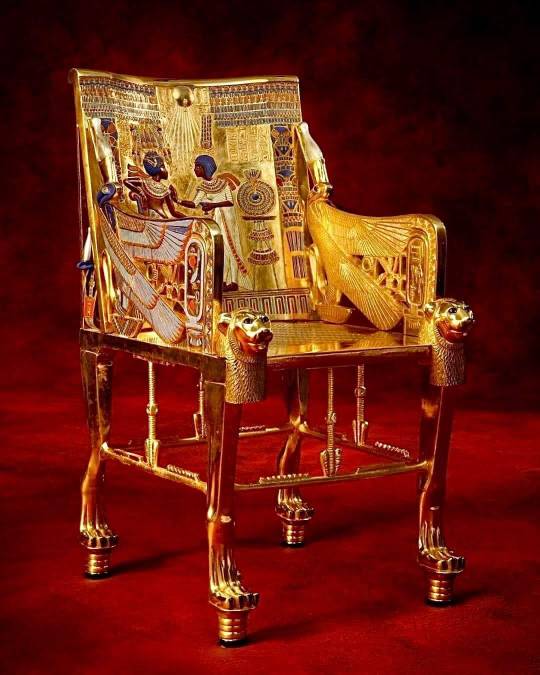
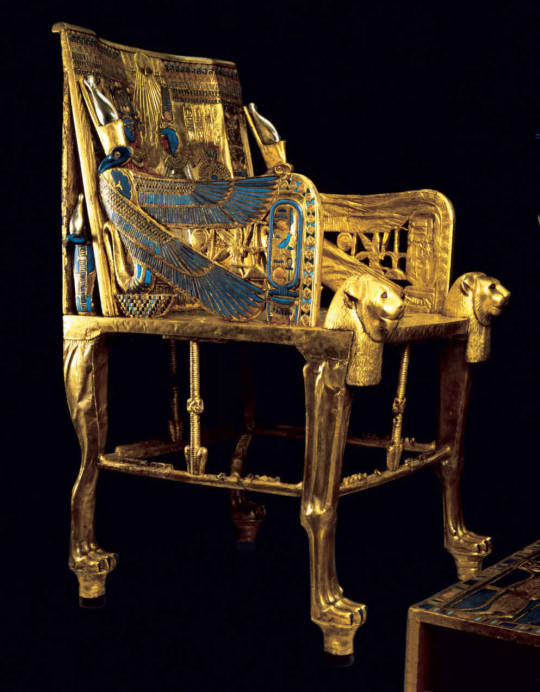

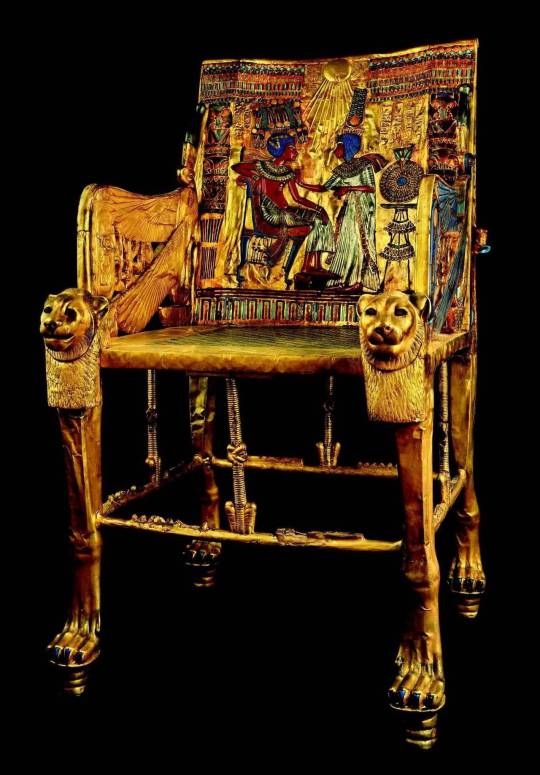

Golden Throne of Tutankhamun
New Kingdom, late 18th Dynasty, reign of Tutankhamun, ca. 1332-1323 BC.
The luxurious armchair is distinguished by the complexity of its technique and an abundance of details. Two projecting lions’ heads protect the seat of the throne while the arms take the form of winged uraei or rearing cobras wearing the double Pschent crown of Egypt and guarding the cartouche names of the king.
The golden throne of Tutankhamun was discovered in 1922 by the British archeologist Howard Carter. It was found beneath a hippopotamus funerary bed in the antechamber of the Tomb of Tutankhamun.
The throne is called (Ist) in Egyptian hieroglyphs after the name of the mother goddess Isis. who was usually depicted bearing a throne on her head as her characteristic emblem. It is made of wood and covered with gold and silver. It is ornamented with semi-precious stones and colored glass.
The throne meant, not only the link between the worlds of Gods and the people, but also majesty, stability, safety and balance. Since kings were considered Gods on earth, it may not be difficult to imagine Tutankhamun imposing his divine will over the rest of mortals while sitting on this golden throne.
Wood, gold leaf, silver, semi-precious stones, glass paste,
Height: 102 cm, Length: 54 cm, Width: 60 cm,
Egyptian Museum, Cairo.
#art#design#history#luxury lifestyle#style#furniture#throne#gold#tutankhamun#egypt#gold leaf#glass#wood#gods#egyptienmuseum#cairo#tomb#new kingdom#armchair
2K notes
·
View notes
Note
omg i loved your “shifting to Italy” post and was wondering if you could do one for ancient egypt? xx (you don’t have to ofc just a suggestion!!)
shifting to ancient egypt? gotch ya.
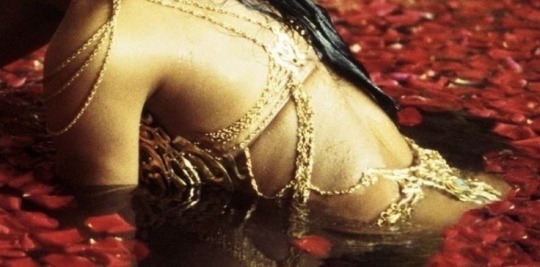
ancient egypt was a cradle of civilization concentrated along the lower reaches of the nile river in northeast africa.
act i. when are you?
based on your time period, you will have very much different experiences. i’d suggest you to research which one you are more interested in shifting.
predynastic ( c. 6000-3150 BCE ) preceding recorded history, saw the development of early settlements and the emergence of distinct cultures in the nile valley.
early dynastic period ( c. 3100-2686 BCE ) marked by the unification of upper and lower Egypt, the first and second dynasties ruled during this time, establishing the foundations of the egyptian state.
old kingdom ( c. 2686-2181 BCE ) a period of great power and prosperity, characterized by the construction of the pyramids and the establishment of the pharaoh as a divine ruler.
first intermediate period ( c. 2181-2040 BCE ) period of political instability and fragmentation following the decline of old kingdom.
middle kingdom ( c. 2040-1640 BCE ) period of reunification and renewed prosperity, with advancements in art, architecture, and literature.
second intermediate period ( c. 1640-1550 BCE ) another period of instability, marked by the rise of the hyksos and the fragmentation of egyptian rule.
new kingdom ( c. 1550-1070 BCE) a period of great expansion and military power, with powerful pharaohs like hatshepsut, akhenaten, and ramses ii.
third intermediate period ( c. 1070-664 BCE ) period of decline and fragmentation, with various dynasties vying for power.
late period ( c. 664-332 BCE ) period of foreign rule, with egypt ruled by the assyrians, egyptians, and persians.
roman period ( 30 BCE - 641 CE ) egypt became a province of the roman empire, marked by roman administration and culture.
act ii. who are you?
you are in the middle of a society who has a strict social structure, and where your status will shape your daily life and power. you are born with it, and only scribes, soldiers and artisans could rise. from the most protected to the least one:
pharaoh. used as a title for absolute monarch since under the new kingdom, often called horus on earth. had control over laws, military, religion, and land. lived in luxurious palaces with servants, and wore a double crown ( pschent ) to symbolise his status as ruler. the most well-known are tutankhamun, ramesses ii, and akhenaten.
pharaoh’s family. wives, children and sibilings had high-ranking positions in the government and religion.
nobles. were high-ranking government officials, including the vizier ( the pharaoh's chief advisor a.k.a prime minister, who oversaw taxes, justice, and administration ) and nomarchs ( governors, controlled egypt’s provinces and managed local social ).
priests. they played a crucial role in religious ceremonies and rituals, and they held significant influence in society.
high priest: appointed by the pharaoh, held the highest authority within the priesthood, performing the most important rituals and managing the temple's affairs.
wab priests: carried out essential but mundane tasks, such as preparing for festivals and maintaining the temple complex.
other priests: who read funeral liturgies ( hery-heb ) who read incantatory formulas from the book of the dead ( khereb priests ) and those involved in mummification ( paraschists, taricheutes, and colchytes ).
priestesses: women could also be priests, with their roles varying depending on the specific cult or deity.
scribes. highly respected, literate individuals who held important administrative and clerical positions, responsible for recording and documenting everything from daily activities to royal decrees. part of the elite 1% of the population that could read and write. they used reed pens, black ink made from soot and gum, adding red oxide to make red ink, and palettes.
artisans. they lived in special workers villages ( deir el-medina ) and included stonecutters, painters, carpenters, sculptors, jewelers, and metalworkers. they created tombs, statues, temples, furniture and luxury goods.
farmers. made up the majority of population and they walked in fields, growing wheat, barley, flax and vegetables. during flood seasons they usually worked with artisans.
slaves. prisoners of war, debtors and criminals. they worked in nobles households ( cooking, cleaning, taking care of children ), temples, mines and quarries; some could earn freedom and better positions over time.
act iii. where are you?
where you live will shape your experience drastically. normal houses were built of mud-bricks with floors made from earth, and they had living rooms, kitchens and bedrooms, and many of the large objects that we can move around ( like seats and ovens ) were built into the house. there was no gas or electricity, meaning that food was cooked in stone ovens, using a fire for heat. to keep food, pits were dug and food was stored below ground level.
cities, they were the heart of the civilisation. center of political activity, religion, and economic powers. in the cities lived pharaohs and nobles ( pharaohs lived in the ‘great house’ or “per ‘aa. palaces were lavish, with evidence suggesting sprawling complexes with large dining rooms, and other amenities reflecting the pharaoh's status ) priests and scribes ( temple complexes, government departments, and even private households, depending on their specific duties and employers ) artisans and merchants ( often lived in distinct workmen's villages like deir el-medina, located near the valley of the kings ) slaves ( lived in simple dwellings, possibly separate from their owners' homes, or within the same household as servants ) but…… what cities? here some examples.
memphis. the capital of the old kingdom. full of loud markets, stone temples, and busy workshops. the most notorious thing are the white walls, the great temple of ptah, statues, palaces ( huge monuments of pharaohs ) craftsmen’s quarters ( people making gold jewelry, statues, and linen ) the nile docks ( ships unloading grain, wine, and goods from nubia and the levant ) …. one of the official religious centers as it was the worship center for the holy triad of the creator god of ptah, his wife sekhmet and nefertem.
thebes. the city of the gods. religious and cultural powerhouse, full of priests, scribes, tomb builders, and travelers. you’d see karnak and luxor temples ( giant temples with sphinx-lined roads ) street performers, food vendors, and boat festivals on the nile. markets full of incense, perfume, and imported goods from the red sea trade.
deir-el medina. there were around 68 houses, made of mud-brick built on stone foundations. letters, legal documents, statues and tombs tell us about family and working life. many of the men and women could read. women baked bread and brewed beer. the village had a court of law and everyone had a right to a trial. there was a local police, the medjay, to keep order. the people of deir-el medina also had medical treatment. they could get prescriptions of ingredients, prayers and spells from the physicians.
act iv. how is your social life?
we are talking about a very social civilisation….. if you were rich. their daily lives revolved around family, work, festivals, and entertainment, and they knew how to balance duty and pleasure ( fun fact: for them sexuality was sacred ).
marriage. frequently arranged by parents, they were a primarily a social and economic arrangement, not a religious or legal ceremony, where couples were considered married once they started living together, often after a party or celebration. while divorce was possible, it was difficult, and women were often protected from divorce by marriage contracts that placed financial burdens on men.
friendship. was significant aspect of life in ancient egypt, strong bonds and social obligations between individuals, including the idea of ‘friends’ being part of a broader social circle beyond immediate family.
banquets. they were lavish celebrations featuring large gatherings of family and friends, music, dance, and copious amounts of food and drink, frequently held near tombs to facilitate communication with the deceased. they were hosted by wealthy families and nobles. entertainment consisted in harpists, flutists, dancers, acrobats. the food ?? roast duck, fish, bread, figs, wine and beer. the banquets were often held in tents or colonnaded spaces, which were sometimes depicted in tomb. fun fact : particularly during banquets and celebrations, people wore scented wax cones on their heads, which melted and released a pleasant fragrance.
public festivals and religious celebrations. the most well-known festivals were: opet festival ( in thebes ) was a celebration of amun and mut’s marriage, statues was paraded through the streets. hathor festival is a wild party with drinking, music, and dance. wepet renpet ( new year’s ) is a huge nile-side festival with feasts and fireworks, celebrated mid-july. beautiful festival of the valley is a state festival, initiated by mentuhotep ii, and celebrated the bonds between the living and the dead, with citizens strengthening their bonds with the deceased. wag festival involved making paper boats containing shrines to souls and setting them out on the river nile to float towards the west, commemorating the death and rebirth of osiris.
markets. like today, bustling marketplaces were a social hotspot. the steet vendors sold jewelry, makeup ( kohl eyeliner and scented oils ) fine linen clothes, sandals, spices, perfumes, and exotic imports.
music. they usually played harps, flutes, drums, and lyres at parties and religious events while women, were often professional dancers, were hired for feasts and ceremonies.
act v. what are you eating?
bread was a fundamental part of the diet, made from emmer wheat or barley. it was eaten at every meal and was considered a basic element of human life.
beer was a common beverage.
vegetables. were a regular part of the egyptian diet, with a variety of options available, including onions, garlic, lentils, and cucumbers.
fish was a readily available and nutritious food source, it was prepared in various ways, including frying, smoking, and boiling.
fruits like figs and dates were also part of the ancient egyptian diet and were often included in offerings to the gods.
oils were derived from ben-nuts, sesame, linseed and castor oils. honey was used as a sweetener, and vinegar may have also been used. seasonings included salt, juniper, aniseed, coriander, cumin, fennel, fenugreek, and poppyseed.
meat. the wealthy would enjoy pork, mutton, and beef.
poultry, such as ducks and geese.
dairy products, like cheese, butter, and cream.
wine was a product of great importance, offered in funerary rituals and in temples to worship gods and consumed daily by the upper classes during meals and parties.
act vi. what are you wearing?
reflected both the hot climate and social status, with the wealthy adorning themselves with finer materials and elaborate jewelry.
linen. the primary fabric, made from the flax plant, was favored for its breathability and comfort in the hot climate.
wool. while known, wool was considered impure and primarily used by the wealthy for overcoats, but was forbidden in temples and sanctuaries.
jewelry. gold, lapis lazuli, turquoise, and other precious materials were used to create elaborate jewelry, including necklaces, rings, bracelets, and amulets.
women’s clothing. they wore full-length dresses with one or two shoulder straps, which could be pleated or draped. the wealthy often wore flowing, sheer dresses layered with colorful shawls or capes.
men’s clothing. kilt-like skirts ( schenti ) are a wrap-around skirt, tied at the waist, with variations in length depending on the era and fashion trends. loincloth and headdresses.
children’s clothing. they wore simple garments, often loincloths or short kilts for boys, and simple linen dresses for girls.
cosmetics. ochre for lips and cheeks, henna for fingernails, and kohl for outlining eyes and coloring eyebrows.
hair. men and women often shaved their heads, and instead they used wigs.
sandals. while many went barefoot, sandals were sometimes worn.
makeup, particularly black kohl eyeliner, was used by both men and women for both aesthetic and practical purposes, with ingredients like galena and malachite used to create pigments, and cosmetics were also seen as having spiritual and protective significance.
kohl eyeliner. a dark, black eyeliner made from ground galena (lead sulfide) and other ingredients like soot, which was used to outline the eyes. it was believed to protect the eyes from the sun's glare and to repel insects. applied in a distinctive style, with lines drawn above and below the eyes, sometimes slightly arched at the ends.
red pigments. red ochre, a clay that was dried in the sun, was used for blush and lipstick and it was also used to stain nails with henna.
green eye shadow. a.k.a malachite, a copper-based mineral, was ground and mixed with water to make a green eyeshadow.
oil and creams. scented oils and creams were used to moisturize the skin and mask body odor. ingredients included myrrh, thyme, marjoram, chamomile, lavender, lily, peppermint, rosemary, cedar, rose, aloe, olive oil, sesame oil and almond oil.
lipstick. red lipstick was made from red ochre and other pigments, theredder the lips, the higher the social status.
note: don’t forget to script safety things!
#kerry's drs#reality shifting#shiftblr#shifting blog#shifting#shifting community#shifting antis dni#shifting motivation#shifting consciousness#shifting diary#shiftingrealities#shiftinconsciousness#shifting ideas#shifting realities#shifting reality#reality shift#shifters#shift#anti shifters dni#how to shift#reality shifter#reality shifting community#shiftblr community#shifting advice#shifting help#shifting journey#shifting methods#shifting script#shifting to desired reality#shifting stories
177 notes
·
View notes
Text

Pectoral of King Shoshenq II
The pectoral of king Shoshenq II displays two falcons at its top, each wearing the Double Pschent Crown of Upper and Lower Egypt. They are sitting upon the hieroglyphic symbol for sky, which is adorned with stars.
Below, resting upon a boat, can be seen a lapis lazuli sun-disc, with an image of the enthroned god Amun-Ra-Horakhty before the goddess Maat at its center.
Third Intermediate Period, 22nd Dynasty, ca. 887-885 BC. Tomb of Shoshenq II at Tanis. Now in the Egyptian Museum, Cairo. JE 72171 Read more
117 notes
·
View notes
Note
Hey, so you seem to be the the All Knowing in terms of twst. With Glorious Masquerade getting a rerun soon, I was looking at the cards.
So what the heck is up with Jamil's freaking hat? I'm sorry but I can't look at it without laughing. It looks so stupid. The closest thing I can think of that matches it is the combined crowns of upper and lower Egypt, but this is the equivalent of France so that can't be it.


While I’m flattered that people come to me with their questions, I want to take a moment to remind everyone that I’m just another TWST fan like you are! ^^ It’s stressful to be considered “all knowing” or a fandom authority 💦 That puts a lot of pressure on me to speak on certain subjects or to interact in a certain way (since people might put too much stock into what I say), and then that ends up detracting from my enjoyment. I’d rather not be put on such a high pedestal, please and thank you.
Now, onto the question!
According to Rollo in 1-13 of Glorious Masquerade, the costumes the NRC students were gifted are “patterned after designs that are over 500 years old.”
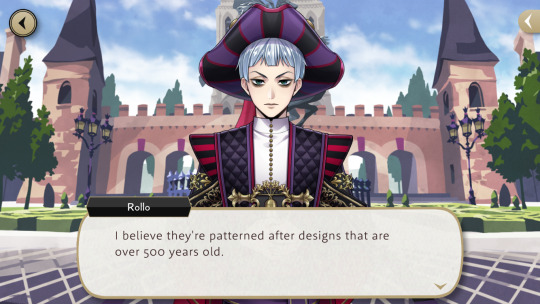
If we extrapolate this to real life, the implication is that these costumes have roots in Renaissance era (14th century to 17th century) French fashion. Interestingly, Rollo’s own hat is similar to a tricorne, which was primarily worn in the 18th century… so technically, his hat is more “modern” than what the NRC students wear 😂
So I browsed through records of hats from the indicated period and guess what? I couldn’t find an exact match—though I did find a lot of hat designs that I found way sillier than what the NRC boys have. Like… sorry, what is THAT 😭
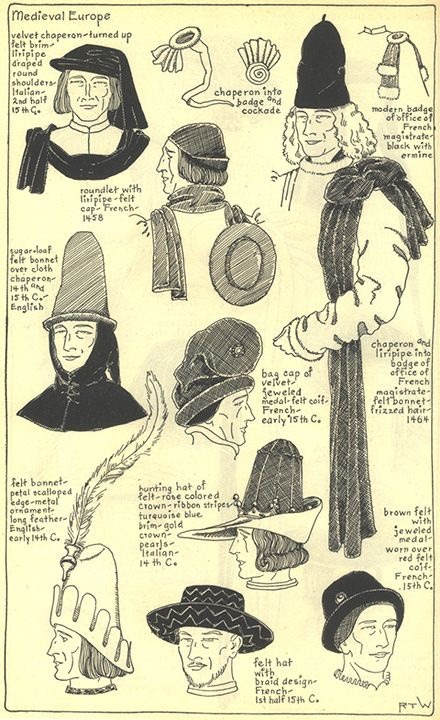
Some headwear which bears a vague similarity to Jamil’s hat are the Egyptian combined/double crown (the pschent), which Anon has already mentioned, and the French hood, which was worn by women in the 15th century.

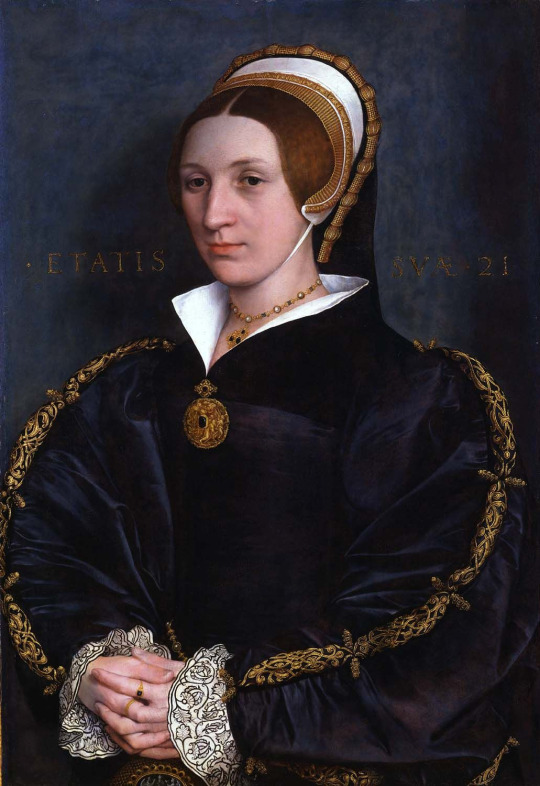
The actual closest match I came across was the mitre, a liturgical headdresses worn by Roman Catholic officials. If you look at it from the front, it doesn’t look like much, but it definitely has the height of Jamil’s hat. But then look closer and you’ll realize the mitre does not have one single flap of fabric, but rather two.

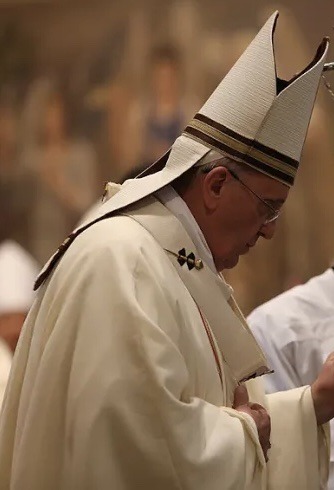
If you take the front flap of a mitre and fold it back, you would probably get something very similar to what Jamil wears. (Note that the black part of the hat is NOT his hair, but is fabric that is part of the hat.)
Considering that Noble Bell College is styled like a cathedral and that the Renaissance era from which the Masquerade Dress clothing derives is characterized by the rediscovery of classical literature, art, and philosophy… perhaps it’s not so strange to see a hat borne of religious associations.
… Why did Jamil specifically get this hat? Not sure, I’m not religious myself so don’t ask me to psychoanalyze him from that angle 😂
The golden part securing the front is unusual and does not appear in French fashion of the time (at least not from what I could tell?). It’s styled like pschent but more likely is meant to be turban-like due to Jamil’s inspiration, Jafar, having the same feather sticking up in the middle of a bulbous hat. You’ll notice Jamil had a “feather” too, albeit metal:
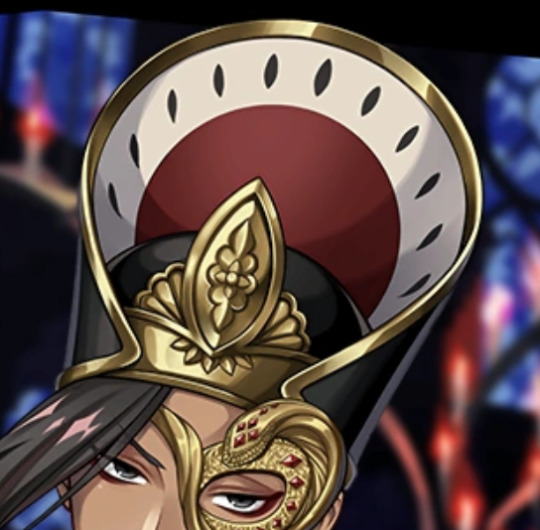
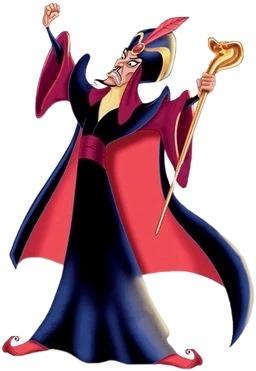
To summarize, I think the design of Masquerade Dress Jamil’s hat borrows from multiple inspirations and not just one/old French fashion. Yana has stated before in a March 2023 interview with the Apple App Store that the cultures of Twisted Wonderland are unique and that the clothing that appears in the game are not “reinterpretations of existing costumes”. She seems to incorporate elements from both high fashion and from a variety of cultures to arrive at the final designs. For example, there are elements of many Nordic cultures in the Apple Pom outfits, and the Pomefiore uniform has a Japanese kimono-like silhouette despite the dorm being based on the the Evil Queen (originating from a German tale). I assume something similar happened when designing the Masquerade Dresses; Yana and co. wanted to combine elements and make something of their own.
Final comment I'll make, the shape of Jamil's hat looks like a kind of dumpling... It makes me hungry.

#twisted wonderland#twst#Jamil Viper#Rollo Flamme#disney twisted wonderland#disney twst#notes from the writing raven#question#glorious masquerade spoilers#advice#evil queen#Jafar
109 notes
·
View notes
Text
Mut
Offerings
Wine, beer, milk, coffee, water.
Meat, bread, fruits and vegetables, lettuce, honey, sweets, cakes, candy,
Frankincense and myrrh, sandalwood, cedar, cypress, lotus, floral smells, along with fresh and clean scents are all good for incense, candles, essential oils, or perfumes.
Precious metals and stones like malachite, carnelian, garnet, gold, silver, and lapis lazuli. You may also offer her jewelry or your makeup.
As a mother goddess, you can offer her children toys or books. Or you may offer her items that you use as a mother including a breast pump (if you’re currently breast feeding, she may help with milk production or help with any blockages in milk ducts).
Imagery of the double crown of Egypt (Pschent), the red crown of Lower Egypt (Deshret), the double feather crown (swty), Hethert-crown, or the crown with the solar disk. Or you can offer her scared items like the menit, sistrum, ankh, was scepter, papyrus scepter, Udjat eye or the uraeus. You may also her imagery specific to her like vulture imagery/figurines, along with cat and lion imagery; she’s also called the ‘great cow,’ too. You may also offer her images of her. You can draw any of these symbols, print them out, or get figurines of them (you can go to the dollar store and get a cheap toy if you can’t afford something more!)
Devotional Acts
Acts of maat. This may include fighting evil, and standing up for what’s right. You may also do this in other aspects too, like knowledge seeking, learning bites of wisdom, becoming an active part of your community, helping out your neighbor or those who are less fortunate. This can also be acts of kindness or love, or doing things for others out of love.
Acts of motherhood/parenthood. Taking care of your children (even if they’re fur children).
As an ‘Eye of Re,’ you can learn how to fight, or learn self defense. This may include just working out. She’s often associated with the bow and arrow, so you could take up archery.
Doing your makeup or dedicating your skincare routine to her! She is a mother goddess and wants you to take care of yourself, but she also has the epithet of ;the lady of the makeup utensils.’ She’s also called ‘the lady of joy,’ so do things that bring you joy like singing, dancing, crafts, etc.
She’s called ‘the lady of the harp,’ and can be seen holding the sistrum, so you could learn how to play either musical instrument. Or, even if you’re not interested in learning them, you can listen to music with those items.
Signs
You may start seeing her scared signs and symbols start appearing more like lionesses, vultures, and cobras. You may also start seeing imagery of the Eye of Re or the Eye of Horus.
You could start seeing images of the harp or sistrum, or you may even start hearing music with the harp start playing. As the lady of jubilation and joy, it can also take the form of some really good music that you can’t help singing along and moving to.
You may start feeling more drawn to doing your makeup and skincare, or you could feel drawn to look into ‘glamor magic.’
You could start feeling a very sweet sensation come over you, one that makes you feel like you’re in a motherly embrace. One that makes you feel warm on the inside and safe.
#mut#offerings; devotional acts; signs#offerings#devotional acts#signs#offerings to mut#devotional acts for mut#signs from mut#egyptian goddess#kemetic#kemetic paganism#kemetism#pagan#ancient kemet#paganism#ancient egypt#deity worship#deity work#kemetic pagan#kemetic religion#kemeticism#kemetic gods
22 notes
·
View notes
Text
Egypt. Ancient Egypt is Africa. BLACK Africa,
Throne fit for a king: Tutankhamun's regal chair, a testament to ancient Egyptian craftsmanship and the grandeur of pharaonic rule. 𓁈 The golden throne of Tutankhamun is a unique work of art. It is considered to be one of the most significant and well-preserved pieces of furniture from ancient Egypt. Its colours have not faded over three thousand years, which serves as a testament to the high skill of the ancient Egyptian craftsmen. The luxurious armchair is distinguished by the complexity of its technique and an abundance of details. Two projecting lions’ heads protect the seat of the throne while the arms take the form of winged uraei or rearing cobras wearing the double Pschent crown of Egypt and guarding the cartouche names of the king. The golden throne of Tutankhamun was discovered in 1922 by the British archaeologist Howard Carter. It was found beneath a hippopotamus funerary bed in the antechamber of the Tomb of Tutankhamun. The throne is called (Ist) in Egyptian hieroglyphs after the name of the mother goddess Isis, who was usually depicted bearing a throne on her head as her characteristic emblem. It is made of wood and covered with gold and silver. It is ornamented with semi-precious stones and coloured glass. The throne meant, not only the link between the worlds of Gods and the people, but also majesty, stability, safety and balance. Since kings were considered Gods on earth, it may not be difficult to imagine Tutankhamun imposing his divine will over the rest of mortals while sitting on this golden throne.
22 notes
·
View notes
Text

The ancient Egyptians wore various crowns, each with its own significance, representing power, divinity, and protection. Here are the main types:
Atef Crown: Symbolizing the power of Osiris, it featured a white crown of Upper Egypt with two ostrich feathers, often worn by pharaohs and gods.
Red Crown (Deshret): Representing Lower Egypt, this crown was flat and circular. It was a symbol of the pharaoh’s rule over the northern region of Egypt.
White Crown (Hedjet): A tall, conical crown representing Upper Egypt. It was worn by pharaohs to signify their authority over the southern part of the country.
Combined Crown (Pschent): The union of the red and white crowns symbolizing the unification of Upper and Lower Egypt under a single ruler.
Blue Crown (Khepresh): Worn during battle and ceremonial events, this crown represented military might and divine protection. It was made from cloth or leather and often adorned with gold.
Uraeus (Cobra Crown): A symbolic crown representing the goddess Wadjet, the cobra signified the pharaoh’s protection by the goddess and their role as the divine ruler.
4 notes
·
View notes
Text

Ring of Ptolemy VI Philometer wearing the pschent, traditional double crown. Geek artwork 3 rd -2 nd century BC. #Louvre_Museum.
#egyptology #archeology #ancientegypt #egyptian #travel #ancient #egipto #egypte #cairo #history #archeology #thisisegypt #visitegypt #ancienthistory #egyptianart #egipt #luxor #egitto #archaeology #pyramids #alrexander_the_great #travelphotography #stater #egyptshots #madeinegypt #drachma #ancientegyptian #hieroglyphs #photography #Ptolemy_I #الصديق_الصدوق
#history#photography#archaeology#greek coins#culture#palestrina#roman coins#travel#sidon saida tyre beirut phoenician الصديق_الصدوق#الصديق_الصدوق#egyptology#Ptolemy_VI_Philometer
9 notes
·
View notes
Text

Horus the Younger (Heru-sa-Aset, Heru-pa-Khered) is an Egyptian god associated with sovereignty, justice, and victory. In myth he is the son of Isis and Osiris and is thus the nephew of Horus the Elder. Horus is a particularly complex deity; he appears under a number of names and in a number of guises, most notably Horus the Elder (Heru-wer) and Horus the Younger (Heru-sa-Aset) but he has other significant aspects as well. He had a particular center of worship in the city of Hierakonopolis (Nekhen). He is depicted here as a man with the head of a hawk, wearing the double crown (pschent) of Upper and Lower Egypt. He carries the was staff, a symbol of power, in one hand and the ankh, a symbol of life, in the other. Horus the Younger may also be depicted as a child, wearing the side-lock of youth, sometimes seated in the lap of his mother Isis.
Heru-sa-Aset, master of magics, just one, savior of your father, I praise and honor you.
5 notes
·
View notes
Text
Crowns of Ancient Egypt
A brief overview of the different kinds of crowns seen in Ancient Egyptian iconography. Note that I say crown, note headdress; the well-known nemes headdress and similar things not worn by the king and gods will not be covered.
Hedjet: translates as “White One,” the crown of Upper Egypt. Most famously worn by Nekhbet, Horus, and Satet. Nekhbet, the Patroness of Upper Egypt, was occasionally placed on the brow of this crown as an ornamental vulture.
Deshret: translates as “Red One,” the crown of Lower Egypt. Most famously worn by Wadjet, Horus, and Neith. Like her sister, Wadjet- the Patroness of Lower Egypt- would commonly adorn the crown as a uraeus. However, this symbol was featured on a majority of the other crowns as well.
Atef: a hedjet crown with two ostrich feathers on opposite sides. Most commonly associated with Osiris and his followers, but was also worn by Underworld related deities like Sokar.
Hemhem: translates as “to shout,” “cry out.” This translation has led to speculation that it was associated with battle or military power. It’s three atef crowns placed side by side atop curled ram horns; sometimes there is a solar disc above each atef, sometimes just the middle one, sometimes not present. Not specifically associated with any one deity, but Khnum and Sobek are often depicted wearing one.
Pschent: also called sekhemty- translating as “the Two Powerful Ones”- it combines the hedjet and deshret to become the crown of a unified Egypt. Though the Pharaoh Menes is said to have first united the crowns, surviving records show Djet was the first to wear it. Horus is the deity most commonly associated with it, but Atum-Ra was also shown wearing the double crown at times. The Two Ladies Nekhbet and Wadjet would both adorn this crown side by side, further symbolizing the union of Upper and Lower Egypt.
Khepresh: known to exist in the second intermediate period, but popularized in the New Kingdom; worn by pharaohs for militaristic and possibly religious purposes. It isn’t associated with any deities, but as with most royal headdresses it often featured a uraeus.
Cap Crown: one of the oldest crowns of Egypt recovered by Egyptologists, depictions of it stretch as far back as the Old Kingdom. Again, no particular deity is associated with it, seemingly exclusive to the human Pharaoh, but it did almost always feature a uraeus.
Solar Crown: also called a solar disc, this was used to not only signify a solar deity but royalty. It’s most commonly associated with Ra, but many other deities have worn one, even if only in rare depictions. Most commonly, the solar crown is also worn by deities like Horus-Ur (Horus the Elder), Isis, Hathor-Sekhmet, Amun, Tefnut, Bast.
Lunar Crown: like the solar crown, this can also be alternatively described as a lunar disc. Unlike its counterpart, however, it was rarely described with a single phrase despite being not uncommon in depictions. The closest it had to its own word was shared with the moon in general. The crown itself was depicted with the full moon resting in the curve of an upturned crescent moon. Deities like Khonsu and Thoth are most associated with this crown, but Tefnut and Mehit also wore it occasionally.
Two-Feathers Crown: also called the Amun crown as it was most commonly associated with him, but it is also worn by Montu and Min. Unlike the atef, these feathers are described as those of a falcon rather than an ostrich- but similar to the hemhem, they’re placed atop two ram horns and sometimes feature a solar disc.
9 notes
·
View notes
Text
Almost done with this one!
Done with the design!

And then to the acid bath:

My acid is old now so i did a 2h bath to be sure . I was very happy with result of the etch:)
From left to right :
Khnum, Sobek, Sekhmet and Neith.
In the middle is my design of a woman pharaoh:) (the wings are usually associated with Isis but it's not her. I used the traditional full pschent and a detailed version of the royal ceremonial outfit from tomb paintings)
The original piece is gold , so they could just pop a little moulded Isis in the middle but i can't, so i chose to experiment with copper hammering.
This is one of the hardest things I've done so far. It's not so bad for a first try but what i learned was that i don't have to correct tools for it. Also that i should have hammered the figure BEFORE engraving-_-. Anyway , enjoy.




I'll update with the blue and green varnish in place when it will be over:)
#nora makes stuff#my crafts#metalwork#egyptian new kingdom jewellery#jewellery#jewlery#jewllery#fuck that word
6 notes
·
View notes
Text

Statue of Horemheb and Horus
In this nearly life-size statue made of white limestone, Horemheb is seated on the right side of Horus, who places his right arm around the king’s waist. The god’s left hand is holding the sign of life. The two figures greatly resemble each other.
Both have bare upper bodies and wear the shendyt kilt and the Pschent or double crown in ancient Egypt. The king is also wearing the striped royal nemes headdress and a false divine beard. On first inspection, the sculpture appears to be in a perfect state of preservation, but this is deceptive.
New Kingdom, late 18th Dynasty, reign of Horemheb, ca. 1319-1292 BC. Now in the Kunsthistorisches Museum, Vienna. Inv. 8301 Read more
381 notes
·
View notes
Text

Heavy is the Head That Wears the Pschent.
4 notes
·
View notes
Text
Horus
Offerings
Water, wine, whiskey, rum, scotch, beer, coffee, milk, juice, hot chocolate, (earthy) teas.
Meat, fish, fruits and vegetables, bread, grains, nuts, honey, cakes and other sweets, too (like chocolate); along with, lemon and other citrus things (cakes, candies, or fruit)
Knives, spears, bow and arrows, whips, harpoons, or other weapons can be dedicated to Heru. You may use anything else that you use to stay safe/ keep yourself safe like your car keys, taser, pocket knives, a bat, etc.
Jewelry or precious stones/metals like gold, silver, bronze, lapis lazuli, carnelian, red jasper, garnet, sunstone, and moonstone.
Items like the feather of maat, the ankh, the was scepter, the Eye of Horus, imagery of his crown, You may also offer him imagery of him (drawings, printed pictures, figurines), the falcon, or the sun and moon.
Devotional Acts
Helping the dying or the deceased. You can become a death doula and help grieving families and help make it easier for those who are passing or it may take the form of working in hospice or in an elderly home. You may also help clean up graves, making their headstone clear of dirt and debris. Horus’ job in antiquity was to revive his father and keep his social standing (you did not want your name forgotten).
As a protective deity, you may start working out, exercising, or taking up classes. Or you may see this as an opportunity to stand up for those who cannot stand up for themselves, whether in conversations or you may go the route of military/ law enforcement (he is known as the avenger of wrongs and defender of order).
Meditation. Meditation has been known to increase mindfulness and help you feel balanced overall, along with yoga.
Acts of maat, too. Maat can be getting involved in your community, helping those who are in need of assistance, donating to charities, helping your neighbor, helping your family; knowledge seeking, learning wisdom (sebayts), holding your tongue when you want to lash out; along with, giving offerings to the dead and to the gods, and performing rituals to them, too.
Signs
You may see an increase in seeing his scared animals like hawks/falcons/eagles (I’ve noticed they’ll use them accordingly based on your area and what’s native there), bulls, rams, or the sphinx.
The most obvious sign would be the wadjet eye- or the Eye of Horus, along with the Double Crown of Egypt (or the Pschent).
As a god of fertility and reviver of Asar, you may see start coming back to life if they’re on death’s door (you still have to put in the effort to try to revive it). Or you may notice you have a stronger “green-thumb.”
Horus of the Horizon is associated with the planet Mars, Horus who Limits the Two Lands is associated with Jupiter, and Horus the Bull of the Heavens is associated with Saturn. You may start seeing imagery based on these planets. Horus also has one eye associated with the sun, the other the moon- so you may start seeing a combination of that imagery or them separate.
You may have waves where you just feel “safe” and “protected.” Or you may get feelings of extreme heat from his solar aspects.
#horus#offerings; devotional acts; signs#offerings to horus#devotional acts for horus#signs from horus#information on egyptian gods#offering to pagan gods#devotional acts#offerings#signs from a deity#kemetic#kemetic paganism#kemetism#ancient kemet#pagan#paganism#ancient egypt#deity worship#deity work
29 notes
·
View notes
Text
*trying to flirt* hey baby wanna come back to my place and see my antique pschent
2 notes
·
View notes
Text
Astral Void (End of the Dream)
“Viens à moi, toi, le rêveur” End of the terrible flight Over the frozen desert I can see the onyx castle Where the pale light shine The pschent of unknown stars Above the myriad domed turrets Glow with a sallow and sickly flare “Come to me, the dreamer You’ve been through so much But face the Old Ones Could lead you to cosmic horror” A Hideous blast of a daemon trumpet Resonates three times in…
0 notes